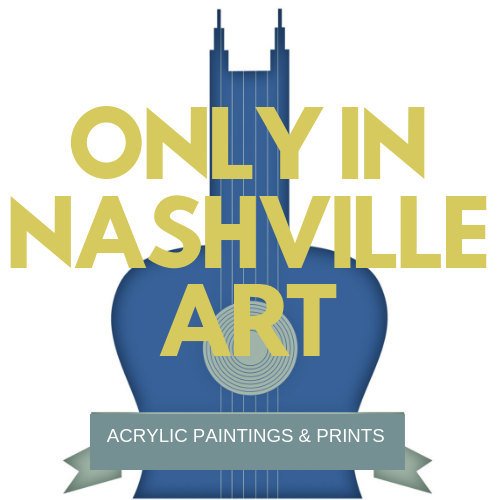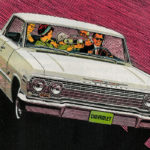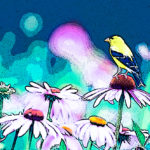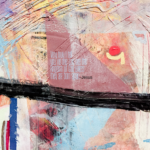What does it mean to be a disciple of Jesus? And what does it mean to be a disciple and an artist? I’ve been asking these questions since April 1982.
I need to give some definition to the words disciple and Jesus. When I write disciple, I’m thinking a student and something like an artistic, Jesus-centric apprenticeship. When I write Jesus, I’m thinking of the person of history as described and quoted in the library of sixty-six books known as the Bible and acknowledged by non-Christian sources too. Such as first-century Jewish historian Flavius Josephus in his 20-volume history of the Jewish people, Jewish Antiquities.
I didn’t come to see myself as an apprentice to Jesus by accident. There’s a story, always a story. Almost a setup. Certainly a plot.
In February of 2005, the British journalist Steve Turner visited our Art House home to speak at a retreat. I’d been familiar with Steve since the 1980’s when I was a regular at Greenbelt, a music and arts festival in England. He’d also lived in Sacramento (our former hometown) for a short six months working on a syndicated radio show named Rock & Religion, later rebranded as Rock Scope. The show ran from 1974 through 1981.
Steve Turner has written definitive best-sellers on Johnny Cash and The Beatles, The Man Called Cash: The Life, Love and Faith of an American Legend(2004) and Beatles ’66: The Revolutionary Year(2016). My favorite book of Steve’s is, Jack Kerouac: Angelheaded Hipster(1996). According to Steve, “Jack Kerouac was essentially a writer with spiritual preoccupations – waiting for God to show his face.”
Kerouac’s buddy, Allen Ginsberg told Steve, “I think that spirituality was our primary thing . . . we all had some kind of visionary experience that pushed us out of the notion of art as just some career or commerce.” Spiritual preoccupations. Visionary experiences. Art, more than just a career or commerce. Check.
In 1983 I met the brain trust behind Rock Scope, Mary Neely and Michael Roe. Along with Steve Turner and another Brit, Steve Scott, Davin Seay also contributed to the radio show. Davin later co-wrote Stairway to Heaven with Mary, a book based on their accumulated research. The show aired on Sunday morning when radio stations met FCC requirements with religious programming. Since Rock Scope was about ferreting out spiritual themes in rock music, it was a double bonus for rock and pop stations. Rock and religion – hence the title. The show included music and interviews with Bob Dylan, The Rolling Stones, Roger McGuinn of the Byrds, T Bone Burnett & the Alpha Band, and many more.
By the time I met Mary Neely and Michael Roe, they had pushed pause on Rock Scopeto get into the record business. They formed Sangre Productions which quickly morphed into Exit Records and distribution deals with Word, A&M, and Island Records. A dozen or so talented musicians were hanging around Warehouse Ministries, the non-denominational Christian church that had sponsored Rock Scope. The idea was to build a recording studio, choose artists and bands from among the ranks, make records with them, and see what happened.
Michael Roe, an accomplished guitarist, had been the announcer for Rock Scope. Now, on the other side of the microphone, he was the front man for the Scratch Band – later to become 77s. In 1981-82, the Scratch Band was one of many bands in Sacramento and San Francisco pitching themselves to me for gigs at the three clubs I played most (and conveniently was in charge of booking). I slotted the Scratch Band in a couple of times because I recognized drummer Mark Proctor from Whitefire, a hometown band that played dances at Yuba City High School when I was a student. Their band house, tucked into an orchard, was where KOBO disc jockey Rick Gibson took me to record the first two songs I’d ever written, “Needless to Say” and “Hey Lady Love.” Recordings I delivered to David Geffen’s Asylum Records office that summer.
Several other musicians had pioneered the path Sangre Productions, and Exit Records hoped to travel. Some religious, some spiritual, and many that self-identified as something called, born again. Larry Norman, Johnny Cash, Al Green, U2, Richie Furay (Buffalo Springfield, Poco), Kerry Livgren (Kansas), Barry McGuire, Philip Bailey (Earth, Wind & Fire), Bruce Cockburn, and Bob Dylan were just a few.
All these musicians had been wooed by the Jesus story. Yet, the range and manner of conviction, adaption, and allowing one’s curiosity and conversion to have a public voice was unique to each musician. In their own way, each sought to answer the questions: What does it mean to be a disciple of Jesus? And what does it mean to be a disciple and an artist? As you might imagine, a variety of answers emerged.
Another such artist and musician was Jimmy Abegg, who I met in late 1982 at Maurice’s American Bar in Sacramento at 15thand Broadway. A storied location, the bar was across the street from the defunct Tower Cut Rate Drug Store. Tower Records founder Russ Solomon got his start there selling used jukebox records. Maurice’s, curated by attorney Maurice Read, was a late 1970’s restaurant and bar for Sacramento’s artists, creative types and left-of-center thinkers (later to be known as Melarkey’s). My wife Andi bartended for a time and I was a regular performer beginning in 1979. It was there that Sal Valentino of the Beau Brummels first heard me. As a result, he took me around to meet various record companies in Los Angeles and lit the fuse on my career as a recording artist.
Jimmy Abegg had come to the club to hear me perform. I was the odd curiosity and exception in Sacramento – a favorite local musician who became a Christian, yet headlined local clubs playing his own music (which no one thought of as Christian music). As reported in The Sacramento Bee, “Charlie Peacock, the superlative keyboardist and bandleader who single-handedly pioneered ‘original’ rock music in Sacramento has undergone a religious conversion and is now a born-again Christian.” And so it was, hyperbole and all.
A few months later, in the same newspaper, David Barton, a local music critic wrote an article under the headline, ROCK’ N’ ROLL IS BORN AGAIN. “Rock ‘n’ roll and Christianity are very much with us” opined Barton. “And there is a new generation of young Christians, raised on rock, who are attempting to blend their faith and their music. Name entertainers such as T Bone Burnett, Marvin Gaye and Irish New-Wavers U2 have openly declared their Christian faith and are using their music to spread the Word.”
Barton quoted me as saying, “It’s an opportunity for new listeners to view the socio-political landscape through the eyes of an artist who professes Jesus of Nazareth as the Christ.” I was trying to sound smarter than I was. The depth of my socio-political knowledge was thin as glass and just as vulnerable.
Jimmy and I quickly became trusted allies. He had traveled the faith and music road just a little longer than me. I considered him my elder and guide. I listened to what Jimmy had to say. He was passionate about Jesus without an ounce of religiosity. His favorite Bible verse was Jeremiah 29:11, “For I know the plans I have for you,” declares the Lord, “plans to prosper you and not to harm you, plans to give you hope and a future.” Just in case it hadn’t stuck the first time, Jimmy repeated this verse often.
U2 were fans of Jeremiah as well. Years later, they put a coded version of Jeremiah 33:3 on the cover of All That You Can’t Leave Behind: “Call to me and I will answer you and tell you great and unsearchable things you do not know.” Bono referred to it as God’s phone number.
Jimmy was no rock star, yet. But he had formerly lived in an actual tee-pee and experimented with LSD. Two distinctions I noted at the time. By way of a circuitous and mystical conversion, Jimmy quit trippin’ to get “high on Jesus,” just like the Kinky Friedman song says. All in all, Jimmy’s combination of quirk and conviction was magnetic.
At one point in our growing friendship, I became convinced that I should set music aside and get some theological education. With animated limbs, Jimmy’s hands waving off the smoke from his cigarette, he argued against me attending the Calvary Chapel Bible School. According to Jimmy, my musical contribution to society would be sufficient.
It was then that Jimmy arranged for me to meet Mary Neely, the Rock Scope founder from Warehouse Ministries in Rancho Cordova, California. Mary was cautious yet curious about me. I was actually doing what she and the Sangre/Exit bands aspired to. So we struck a deal. I would become part of this unique experiment of a Christian church sponsoring recording artists, ones committed to art-centric work and to embodying the answers to those two unrelenting questions. What does it mean to be a disciple of Jesus? And what does it mean to be a disciple and an artist?
In America, in the 1970s and ’80s, the second question was so far down the list of what mattered to the Christian church, it was roughly non-existent. Francis Schaeffer’s Art & the Bible was of some help, as well as the work of Calvin Seerveld (Canada), Hans Rookmakker (The Netherlands) and Nigel Goodwin (the UK, and Greenbelt in particular). Steve Turner was unquestionably a pioneer thinker, and his seminal book, Hungry for Heaven: Rock and Roll and the Search for Redemption proved it. Mary Neely though, she saw a bit of the future like no one else.
I wouldn’t have characterized myself as hungry for heaven, as much as perennially God-haunted. When I retrace history through the lens of age and experience, all I see is the intertwining of art and spirituality – even seeking Jesus. It’s clear now that I’d been trying to answer life-saving, cosmic questions long before I took Jesus at his word.
As a teenager and young adult, I studied the writer/poets Jack Kerouac and Gary Snyder with the same verve I gave to memorizing the monthly contents of RollingStone magazine. This opened up the world to me and set me on a strict non-conformist path. Still, no matter how far out new vistas took me, Jesus always seemed nearby. It was the same for Kerouac. Steve Turner wrote, ““After taking LSD with Allen Ginsberg and Timothy Leary – during the trip Jack was shouting to Leary: “Can your drugs absolve the mortal and venial sins which our beloved Savior Jesus Christ, the only Son of God, came down and sacrificed his life upon the cross to wash away?””
When I was seventeen and attending junior college, I had the idea of bringing Gary Snyder to the school. I wrote a letter, and he came. What Gary Snyder represented to me was a person integrated with the land, in search of enlightenment, who was artistic and loved words. He found a way to bridge post-WWII ideas about manhood with a new mindset of openness and generosity to people and place. I imagined him good with both an ax and a dream. The stage was set. I wanted to be someone good with words, music, and a dream.
John Coltrane had a measurable influence on the direction of my life as well. His most commercially successful recording, A Love Supreme, is Coltrane bringing the full weight of his spiritual quest into the public square – a pursuit I signed up for decades ago. In the liner notes, Coltrane announces, “Dear Listener: ALL PRAISE BE TO GOD WHOM ALL PRAISE IS DUE.”
Coltrane was a religious syncretist, and so was I for a decade or so. Like Coltrane, the only way I could make peace with all the differing views about religion and God was to create my own fusion of them. I wanted all the paths to lead to the same God. This was tough to do with Jesus, since he’d been quoted as saying, “I am the way, and the truth, and the life. No one comes to the Father except through me (John 14:6-7).” Something of an outrageous claim (see C.S. Lewis’ trilemma).
I couldn’t have stopped bumping into artists and their spiritual inclinations if I’d tried.
I was in Los Angeles in 1980, at the very beginning of my artist career, meeting with labels and showcasing at The Troubadour. Michael Stone, my manager, was employed by Warner Brothers Records in Burbank. He worked closely with a solo artist named Gary Wright. Michael thought Gary might be the right person to produce my debut album. I knew of Gary from his songs, “Love is Alive” and “Dream Weaver.” Two chart-topping hits, ubiquitous in 1976. The latter, inspired by a book given to him by George Harrison of The Beatles. And so it was that I found myself at Gary’s home and studio for a surreal afternoon of sharing music, his spirituality (guru Paramahansa Yogananda) and admiring his collection of instruments, several given to him by George – his most frequent collaborator (and fellow follower of Yogananda). George had his own religion-inspired hit, “My Sweet Lord.” A song I sang in the choir at First Christian Church, Marysville, California, 1971. My dad edited the lyrics to be exclusively Christian.
Time with the Dream Weaver was no one-off exception.
I had been to the Ananda commune, founded by Swami Kriyananda, up near Gary Snyder’s home, on the San Juan Ridge (both swami and guru mean spiritual teacher). For a time, the Tao Te Ching was my morning devotion, and I studied the popular Buddhism of Allan Watts and D.T. Suzuki. I also went to a Transcendental Meditation orientation to receive a mantra and had to punt. I didn’t have money for the required flowers. No flowers, no mantra. The jazz bassist Marc Johnson introduced me to the writings of Krishnamurti. Rudolph Steiner and anthroposophy had been at the heart of a short-lived gig with the Sacramento funk band, The Runners.
In his early days, Swami Kriyananda was associated with Paramahansa Yogananda and the Self-Realization Fellowship in Encinitas, California. When I first met drummer Aaron Smith, he, like Wright and Harrison, was a disciple of Yogananda. He still was when I got him the gig playing drums on the 1983 Vector recording, Mannequin Virtue, produced by Steven Soles of Bob Dylan’s Rolling Thunder Revue.
Encinitas is uniquely interwoven with my story and my dreams. In 1996 I envisioned signing a particular type of band to my new indie record label, re:think. I could hear it in my head – it was as current as the moment I was standing in. So successful were rock bands at that time, there was even a genre, Modern Rock. Unbeknownst to me, an EMI sales manager, Buz Buzbee, had dropped by my studio and left a cassette tape of Chin Up, a three-piece band of young musician-surfers from Encinitas. It took a while, but eventually, I came across it and listened (it was in a teetering stack of unsolicited tapes). Within minutes I was on the phone intending to sign them – and within weeks, had. They became Switchfoot and have had a remarkable career.
When Andi and I visit Encinitas, we have at least one breakfast at Swami’s, a café on the coastal highway, and diagonally across from the Self-Realization Fellowship. On the other side of the gold-domed compound are the Pacific Ocean and the beach where Switchfoot surf. When there, I often think of my old friend Aaron Smith, and how, over time, he became convinced that Jesus was a more trustworthy teacher than Yogananda. Jesus is the Teacher, but never guru or swami. Messiah, yes.
What does it mean to be a disciple of Jesus? And what does it mean to be a disciple and an artist? Switchfoot, in word and work, has made a beautiful life of answering these questions. So has Aaron. I’ve tried to put my answers in the things I’ve made and said. I’m still breathing and creating, which means I rise each day to answer again.
It’s been a long, God-haunted journey since I was a boy, reading the Bible and picking out the blues on a church piano. It’s been a setup. One long unfolding plot line and living answer.
Jimmy Abegg, the prescient prophet had it right quoting the prophet Jeremiah so often. “For I know the plans I have for you,” declares the Lord, “plans to prosper you and not to harm you, plans to give you hope and a future.”
The Husband has a new vocal album out now, available everywhere. Here are a few links:
SPOTIFY




Andi and Charlie, thanks for your poignant posts. Like you, I am from Yuba City, born at Rideout Hospital in Marysville. I am part of the large Tokunaga clan in Yuba City. Charlie, you know my cousin Joanne Tokunaga Devine.
I will be in Yuba City/Marysville for a large Tokunaga reunion this weekend. I spent summers as an adolescent in Yuba City so I have many fond memories. Every once in a blue moon, I’ll be somewhere, take a breath and I feel like I’m breathing Yuba City air.
Thank you for your long obedience in the same direction. Coming from generations of Buddhists from Yuba City, I feel a unique connection with disciples of Jesus from Yuba City. I’ll be thinking of both of you this weekend.
Warmly,
Paul Tokunaga
Atlanta
InterVarsity staff for 46 years (not in the Buddhist Playbook!)
Paul, I so appreciate your note. I was born in Rideout Hospital also. And Joanne is one of my oldest and dearest friends. We’ve stayed in good touch throughout the years. We lived around the corner from each other on Smith Road from 2nd grade until post-high school, and were at each other’s houses most every day. I went to some large Tokunaga gatherings in those years. I wonder if I’ve ever met you? In any case, thank you for writing. It’s lovely to hear from you.~Andi